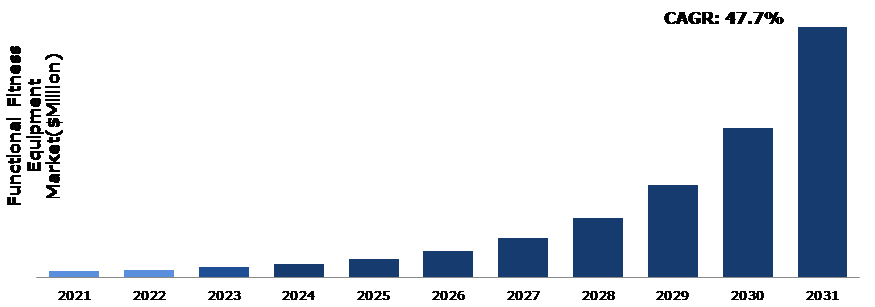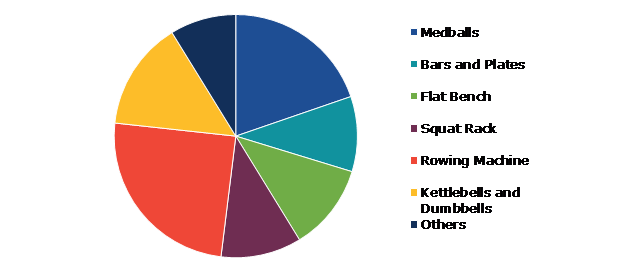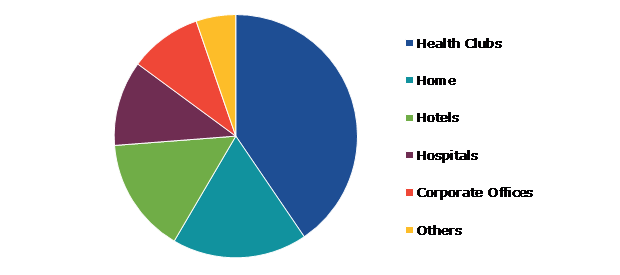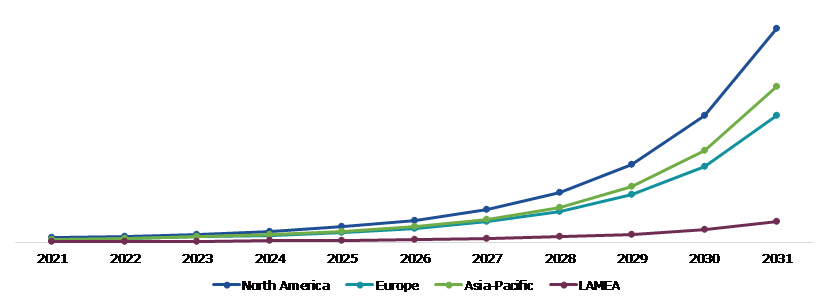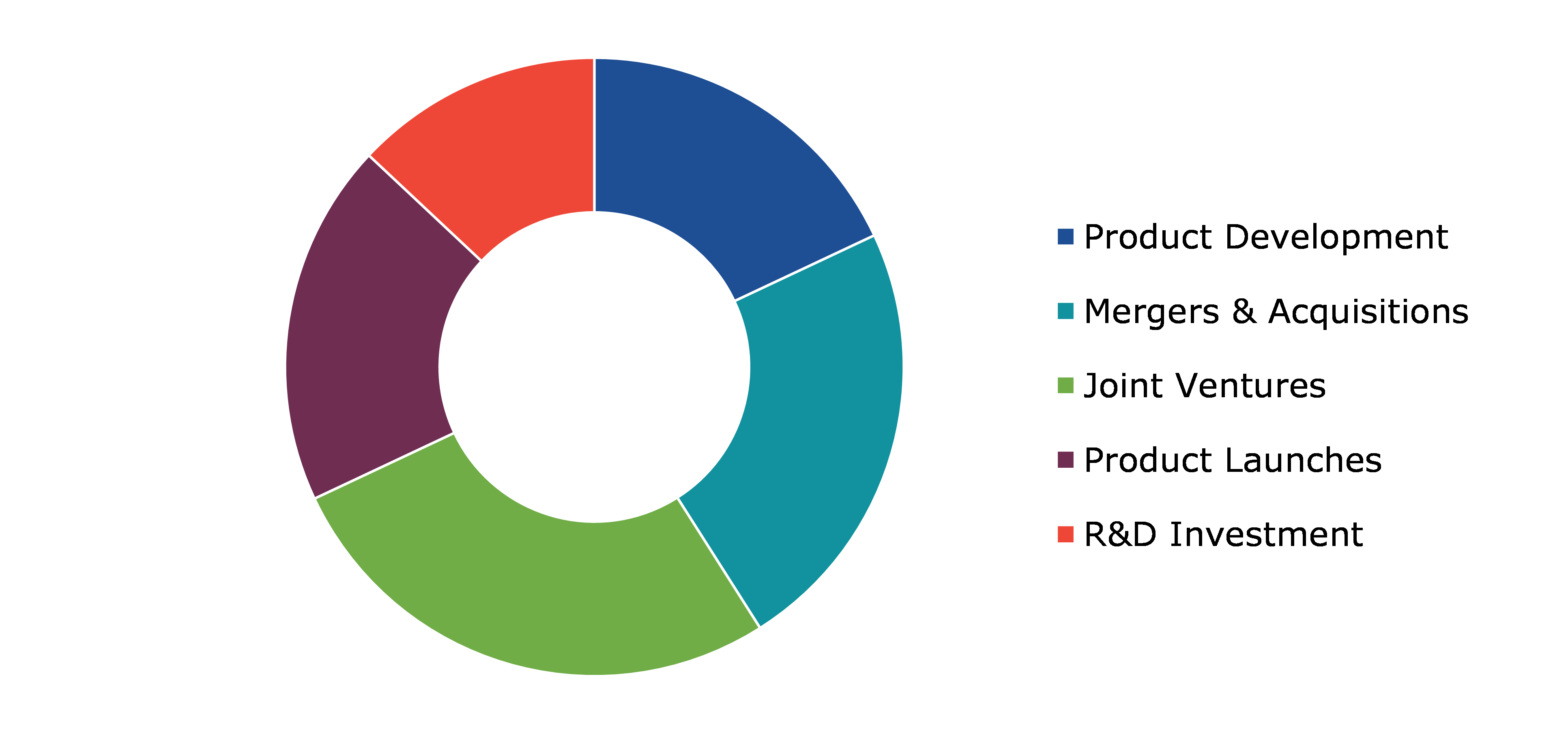Global Functional Fitness Equipment Market Report
RA08657
Global Functional Fitness Equipment Market by Type (Medballs, Bars and Plates, Flat Bench, Squat Rack, Rowing Machine, Kettlebells and Dumbbells, and Others), Application (Health Clubs, Home, Hotels, Hospitals, Corporate Offices, and Others), and Region (North America, Europe, Asia-Pacific, and LAMEA): Global Opportunity Analysis and Industry Forecast 2022–2031
Global Functional Fitness Equipment Market Analysis
The Global Functional Fitness Equipment Market Size was $6,325.0 million in 2021 and is predicted to grow with a CAGR of 47.7%, by generating a revenue of $2,73,315.2 million by 2031.
Global Functional Fitness Equipment Market Synopsis
The functional fitness equipment includes any apparatus needed for physical activity to control body weight, increase physical endurance, and build muscular strength. Global demand for functional fitness equipment has increased as people's awareness of their health has grown. Exercise is also suggested when receiving some medical treatments. Medballs, bars and plates, flat bench, squat rack, rowing machine, and others are some of the most frequently utilized exercise equipment. The expansion of the worldwide functional fitness equipment market growth has been greatly helped by the rise in health consciousness and the prevalence of obesity. Additionally, increase in functional fitness equipment memberships, rise in the selling of in-home equipment, surge in the urban population, and increase in government measures to support healthy lifestyle drive the adoption of functional fitness equipment market growth. These factors are anticipated to boost the functional fitness equipment market share in the upcoming years.
However, LED consoles, heart rate grips, motors, handlebars, tension knobs, and other parts and components used in workout equipment are hard to come across, and the majority of these are difficult to fix. As a result of this, the entire fitness group must be replaced, raising overall maintenance expenses. This factor would restrict the market's expansion for fitness equipment during the forecast period.
The world is facing a rise in chronic illnesses such as high blood pressure, diabetes, and arthritis as a result of lifestyle changes, dietary shifts, and excessive consumption of high-calorie foods. People are more aware of their health and fitness now than they were previously because of the frequency of the diseases. Due to the frequent consumption of fast food and alcoholic beverages, young individuals are at risk of early bone and muscle weakening. They are aware of these problems, and thus, going to fitness centers and working out has grown popular. The key factor fueling the growth of the fitness equipment market is the rising demand for a fit and healthy lifestyle.
According to regional analysis, the North America functional fitness equipment market analysis is projected to have a dominant market share during the forecast period. This is because non-profit organizations such as USA Functional Fitness (USAFF) have conducted functional fitness championships in the U.S., which have had a significant influence on the region's functional fitness industry expansion.
Functional Fitness Equipment Overview
Functional fitness equipment is equipment that allows the body to move in a manner similar to how it would move in normal life scenarios. This enables for whole body movement in all directions and resembles motions performed at work, in sports, and in everyday life. Barbells dumbbells, balance balls, boards, kettlebells and beams, and cable balls are all essential pieces of functional fitness equipment. This provides for complete flexibility of all bodily motions that simulate daily chores and activities. This places the body in a situation in which the person defines the training patterns and is accountable for providing core and synergetic muscle stability. TRX Suspension Trainers and kettlebells are examples of functional fitness equipment market forecast period.
COVID-19 Impact on Global Functional Fitness Equipment Market
The COVID-19 pandemic has had a significant impact on the fitness equipment sector. To prevent the spread of the virus, the pandemic has enforced new norms and laws, such as social separation and lockdowns. As a result, individuals all around the world were forced to stay at home, generating new trends like work from home. Throughout the pandemic, the rising popularity of home exercises has raised the need for fitness equipment. In the aftermath of the pandemic, the increasing focus on self-care, exercise, and wellness has helped fitness applications and platforms acquire substantial acceptance.
Despite the fact that the novel coronavirus pandemic had a severe effect on various industries, the home functional fitness equipment market witnessed tremendous development during this period.
The importance of a healthy lifestyle and exercising regularly has not decreased with the development of COVID-19 but has changed dramatically. During the government-imposed lockdown to prevent the spread of the coronavirus sickness, many people sought to relieve stress by adopting healthy practices. During the pandemic, the demand for workout equipment has increased. Health issues have grown, therefore, individuals have started to choose for exercise, cardiac exercise, and yoga to enhance their immunity, resulting in an increase in demand for home functional fitness equipment. As a result, the value of excellent health has risen, driving market growth.
Increasing Number of Individuals Participating in Physical Activity Competitions to Drive the Market Growth
Physical activity is beneficial to the body and mind, and it helps in the prevention and management of noncommunicable diseases such as cardiovascular disease, cancer, and diabetes. People all around the world may now take their hard fitness training results to competitive tournaments and put their talents to the test at various functional fitness competitions. Bodybuilding, powerlifting, fun runs, long distance running events, and cross-fit competitions are just a few examples of fitness activity competitions. Many businesses and fitness organizations have taken the lead and organized a variety of fitness competitions and outdoor activities. As a result, the growing number of people participating in physical activities drives market growth.
To know more about global functional fitness equipment market drivers, get in touch with our analysts here.
High Cost Associated With Fitness Equipment to Restrain the Market Growth
The functional fitness equipment accessible at very expensive prices, particularly for middle and low-income people in emerging and undeveloped nations, operates as a growth constraint. The price of high-tech exercise equipment and fitness wearable devices has risen as a result of technical innovation. Adding various features such as high-definition display, extra vitals tracking, greater power efficiency, wireless connectivity, and enhanced software, among others, directly raises the original cost of the functional fitness equipment and fitness device. The usage of wearable devices by various customers is boosting their expenditure on fitness healthcare. Increased application coverage by wearable devices increases demand, which directly contributes to its high cost.
Increase In Health Club Memberships to Enhance Fitness Equipment Deployment to Drive Excellent Opportunities
Increased awareness of the benefits of fitness and healthy lifestyle has resulted in increased membership in health clubs. These facilities offer a wide range of services and equipment to customers, allowing them to participate in a wide range of workout routines. Health clubs also specifically target health issues, assisting clients in developing a personalized workout regimen. Health and wellness clubs are primed to gain considerable popularity with massive memberships, driving the need for current workout functional fitness equipment market during the forecast period.
To know more about global functional fitness equipment market opportunities, get in touch with our analysts here.
Global Functional Fitness Equipment Market, by Type
Based on type, the market has been divided into medballs, bars and plates, flat bench, squat rack, rowing machine, kettlebells and dumbbells, and others. Among these, the rowing machine sub-segment accounted for the highest market share in 2021 whereas the medballs sub-segment is estimated to show the fastest growth during the forecast period.
Global Functional Fitness Equipment Market Share, by Type, 2021
Source: Research Dive Analysis
The rowing machine sub-type is projected to have a dominant market share during the forecast period. A rowing machine, also known as an ergometer, allows consumers to gain the advantages of a rowing workout indoors. Rowing offers several advantages, including increasing endurance and strengthening body. It has even been shown in testing to promote heart health. As compared to other workout equipment like a treadmill or elliptical, the ergometer packs a powerful punch. Rowing machines are projected to dominate the market due to its popularity of integrated cardiovascular features with anti-muscle design.
The medballs sub-type is predicted to be the fastest growing segment during the forecast period. Medicine balls are an important tool for assisting patients in their recovery from injuries. The balls exercise the entire body without putting undue strain on joints, hence they provide an effective but gentle technique to help the body develop endurance following an injury or setback. Medicine balls are a common therapy device for people with knee, shoulder, and even spinal problems. People's increased fitness awareness and interest for home training equipment is a key factor driving the medicine ball segment. A growing number of gym and health club members are keen on engaging in various types of exercise activities, which is expected to boost the worldwide medicine ball segment.
Global Functional Fitness Equipment Market, by Application
Based on application, the market has been divided into health clubs, home, hotels, hospitals, corporate offices, and others. Among these, the health clubs sub-segment accounted for highest revenue share in 2021.
Global Functional Fitness Equipment Market Size, by Application, 2021
Source: Research Dive Analysis
The health clubs sub-segment is anticipated to generate the maximum revenue during the forecast period. Since health-related factors are fueling the expansion of the global industry, consumers are ready to spend more money at health club facilities. With personal training and the newest exercise equipment, consumers are driven to the increasing number of health clubs, which is anticipated to have a positive effect on the market's growth. In addition, rising consumer demand is fueling the growth of the health club sector. These factors are anticipated to boost the growth of health club sub-segment during the analysis timeframe.
Global Functional Fitness Equipment Market, Regional Insights
The functional fitness equipment market was investigated across North America, Europe, Asia-Pacific, and LAMEA.
Global Functional Fitness Equipment Market Size & Forecast, by Region, 2021-2031 (USD Million)
Source: Research Dive Analysis
The Market for Functional Fitness Equipment in North America to be the Most Dominant
The North America functional fitness equipment market is projected to have a dominant market share during the forecast period. In terms of revenue and membership in functional fitness equipment, the U.S. is the single largest market in the North American region. Furthermore, many people who are worried about their health have made exercise a priority in their daily routine. Moreover, increased obesity and physical inactivity have been a major problem in the U.S. and Canada, owing to which fitness clubs and health centers are gaining popularity and are therefore predicted to expand the market.
Competitive Scenario in the Global Functional Fitness Equipment Market
Investment and agreement are common strategies followed by major market players. For instance, August 2021 Johnson Health Tech (JHT) acquired Matrix Fitness South Africa, a distributor for JHT prior to the acquisition, making JHT the first producer of fitness equipment to establish a fully-owned subsidiary in Africa.
Source: Research Dive Analysis
Some of the leading functional fitness equipment market players are Concept2, Precor SA Technogym, Johnson Health Tech, Torque Fitness, Hampton Fitness, Escape Fitness, Total Gym Global, Brunswick Corporation, and XFit Brands.
| Aspect | Particulars |
| Historical Market Estimations | 2020 |
| Base Year for Market Estimation | 2021 |
| Forecast Timeline for Market Projection | 2022-2031 |
| Geographical Scope | North America, Europe, Asia-Pacific, and LAMEA |
| Segmentation by Type |
|
| Segmentation by Application |
|
| Key Companies Profiled |
|
Q1. What is the size of the global functional fitness equipment market?
A. The size of the global functional fitness equipment market size was over $6,325.0 million in 2021 and is projected to reach $2,73,570.4 million by 2031.
Q2. Which are the major companies in the functional fitness equipment market?
A. Concept2, Precor SA, Technogym, and Johnson Health Tech are some of the key players in the global functional fitness equipment market.
Q3. Which region, among others, possesses greater investment opportunities in the near future?
A. The Asia-Pacific region possesses great investment opportunities for investors to witness the most promising growth in the future.
Q4. What will be the growth rate of the Asia-Pacific functional fitness equipment market?
A. Asia-Pacific functional fitness equipment market share is anticipated to grow at 49.6% CAGR during the forecast period.
Q5. What are the strategies opted by the leading players in this market?
A. Agreement and investment are the two key strategies opted by the operating companies in this market.
Q6. Which companies are investing more on R&D practices?
A. Concept2, Precor SA, Technogym, Johnson Health Tech, and Torque Fitness are the companies investing more on R&D activities for developing new products and technologies.
1.Research Methodology
1.1.Desk Research
1.2.Real time insights and validation
1.3.Forecast model
1.4.Assumptions and forecast parameters
1.5.Market size estimation
1.5.1.Top-down approach
1.5.2.Bottom-up approach
2.Report Scope
2.1.Market definition
2.2.Key objectives of the study
2.3.Report overview
2.4.Market segmentation
2.5.Overview of the impact of COVID-19 on Global functional fitness equipment market
3.Executive Summary
4.Market Overview
4.1.Introduction
4.2.Growth impact forces
4.2.1.Drivers
4.2.2.Restraints
4.2.3.Opportunities
4.3.Market value chain analysis
4.3.1.List of raw material suppliers
4.3.2.List of manufacturers
4.3.3.List of distributors
4.4.Innovation & sustainability matrices
4.4.1.Technology matrix
4.4.2.Regulatory matrix
4.5.Porter’s five forces analysis
4.5.1.Bargaining power of suppliers
4.5.2.Bargaining power of consumers
4.5.3.Threat of substitutes
4.5.4.Threat of new entrants
4.5.5.Competitive rivalry intensity
4.6.PESTLE analysis
4.6.1.Political
4.6.2.Economical
4.6.3.Social
4.6.4.Technological
4.6.5.Environmental
4.7.Impact of COVID-19 on global functional fitness equipment market
4.7.1.Pre-covid market scenario
4.7.2.Post-covid market scenario
5.Functional Fitness Equipment Market Analysis, by Type
5.1.Overview
5.2.Medballs
5.2.1.Definition, key trends, growth factors, and opportunities
5.2.2.Market size analysis, by region, 2022-2031
5.2.3.Market share analysis, by country, 2022-2031
5.3.Bars and Plates
5.3.1.Definition, key trends, growth factors, and opportunities
5.3.2.Market size analysis, by region, 2022-2031
5.3.3.Market share analysis, by country, 2022-2031
5.4.Flat Bench
5.4.1.Definition, key trends, growth factors, and opportunities
5.4.2.Market size analysis, by region, 2022-2031
5.4.3.Market share analysis, by country, 2022-2031
5.5.Squat Rack
5.5.1.Definition, key trends, growth factors, and opportunities
5.5.2.Market size analysis, by region, 2022-2031
5.5.3.Market share analysis, by country, 2022-2031
5.6.Rowing Machine
5.6.1.Definition, key trends, growth factors, and opportunities
5.6.2.Market size analysis, by region, 2022-2031
5.6.3.Market share analysis, by country, 2022-2031
5.7.Kettlebells and Dumbbells
5.7.1.Definition, key trends, growth factors, and opportunities
5.7.2.Market size analysis, by region, 2022-2031
5.7.3.Market share analysis, by country, 2022-2031
5.8.Others
5.8.1.Definition, key trends, growth factors, and opportunities
5.8.2.Market size analysis, by region, 2022-2031
5.8.3.Market share analysis, by country, 2022-2031
5.9.Research Dive Exclusive Insights
5.9.1.Market attractiveness
5.9.2.Competition heatmap
6.Functional Fitness Equipment Market, by Application
6.1.Overview
6.2.Health Clubs
6.2.1.Definition, key trends, growth factors, and opportunities
6.2.2.Market size analysis, by region, 2022-2031
6.2.3.Market share analysis, by country, 2022-2031
6.3.Home
6.3.1.Definition, key trends, growth factors, and opportunities
6.3.2.Market size analysis, by region, 2022-2031
6.3.3.Market share analysis, by country, 2022-2031
6.4.Hotels
6.4.1.Definition, key trends, growth factors, and opportunities
6.4.2.Market size analysis, by region, 2022-2031
6.4.3.Market share analysis, by country, 2022-2031
6.5.Hospitals
6.5.1.Definition, key trends, growth factors, and opportunities
6.5.2.Market size analysis, by region, 2022-2031
6.5.3.Market share analysis, by country, 2022-2031
6.6.Corporate Offices
6.6.1.Definition, key trends, growth factors, and opportunities
6.6.2.Market size analysis, by region, 2022-2031
6.6.3.Market share analysis, by country, 2022-2031
6.7.Others
6.7.1.Definition, key trends, growth factors, and opportunities
6.7.2.Market size analysis, by region, 2022-2031
6.7.3.Market share analysis, by country, 2022-2031
6.8.Research Dive Exclusive Insights
6.8.1.Market attractiveness
6.8.2.Competition heatmap
7.Functional Fitness Equipment Market, by Region
7.1.North America
7.1.1.U.S.
7.1.1.1.Market size analysis, by Type, 2022-2031
7.1.1.2.Market size analysis, by Application, 2022-2031
7.1.2.Canada
7.1.2.1.Market size analysis, by Type, 2022-2031
7.1.2.2.Market size analysis, by Application, 2022-2031
7.1.3.Mexico
7.1.3.1.Market size analysis, by Type, 2022-2031
7.1.3.2.Market size analysis, by Application, 2022-2031
7.1.4.Research Dive Exclusive Insights
7.1.4.1.Market attractiveness
7.1.4.2.Competition heatmap
7.2.Europe
7.2.1.Germany
7.2.1.1.Market size analysis, by Type, 2022-2031
7.2.1.2.Market size analysis, by Application, 2022-2031
7.2.2.U.K.
7.2.2.1.Market size analysis, by Type, 2022-2031
7.2.2.2.Market size analysis, by Application, 2022-2031
7.2.3.France
7.2.3.1.Market size analysis, by Type, 2022-2031
7.2.3.2.Market size analysis, by Application, 2022-2031
7.2.4.Spain
7.2.4.1.Market size analysis, by Type, 2022-2031
7.2.4.2.Market size analysis, by Application, 2022-2031
7.2.5.Italy
7.2.5.1.Market size analysis, by Type, 2022-2031
7.2.5.2.Market size analysis, by Application, 2022-2031
7.2.6.Rest of Europe
7.2.6.1.Market size analysis, by Type, 2022-2031
7.2.6.2.Market size analysis, by Application, 2022-2031
7.2.7.Research Dive Exclusive Insights
7.2.7.1.Market attractiveness
7.2.7.2.Competition heatmap
7.3.Asia-Pacific
7.3.1.China
7.3.1.1.Market size analysis, by Type, 2022-2031
7.3.1.2.Market size analysis, by Application, 2022-2031
7.3.2.Japan
7.3.2.1.Market size analysis, by Type, 2022-2031
7.3.2.2.Market size analysis, by Application, 2022-2031
7.3.3.India
7.3.3.1.Market size analysis, by Type, 2022-2031
7.3.3.2.Market size analysis, by Application, 2022-2031
7.3.4.Australia
7.3.4.1.Market size analysis, by Type, 2022-2031
7.3.4.2.Market size analysis, by Application, 2022-2031
7.3.5.South Korea
7.3.5.1.Market size analysis, by Type, 2022-2031
7.3.5.2.Market size analysis, by Application, 2022-2031
7.3.6.Rest of Asia-Pacific
7.3.6.1.Market size analysis, by Type, 2022-2031
7.3.6.2.Market size analysis, by Application, 2022-2031
7.3.7.Research Dive Exclusive Insights
7.3.7.1.Market attractiveness
7.3.7.2.Competition heatmap
7.4.LAMEA
7.4.1.Brazil
7.4.1.1.Market size analysis, by Type, 2022-2031
7.4.1.2.Market size analysis, by Application, 2022-2031
7.4.2.Saudi Arabia
7.4.2.1.Market size analysis, by Type, 2022-2031
7.4.2.2.Market size analysis, by Application, 2022-2031
7.4.3.UAE
7.4.3.1.Market size analysis, by Type, 2022-2031
7.4.3.2.Market size analysis, by Application, 2022-2031
7.4.4.South Africa
7.4.4.1.Market size analysis, by Type, 2022-2031
7.4.4.2.Market size analysis, by Application, 2022-2031
7.4.5.Rest of LAMEA
7.4.5.1.Market size analysis, by Type, 2022-2031
7.4.5.2.Market size analysis, by Application, 2022-2031
7.4.6.Research Dive Exclusive Insights
7.4.6.1.Market attractiveness
7.4.6.2.Competition heatmap
8.Competitive Landscape
8.1.Top winning strategies, 2022
8.1.1.By strategy
8.1.2.By year
8.2.Strategic overview
8.3.Market share analysis, 2022
9.Company Profiles
9.1.Concept2
9.1.1.Overview
9.1.2.Business segments
9.1.3.Product portfolio
9.1.4.Financial performance
9.1.5.Recent developments
9.1.6.SWOT analysis
9.2.Precor SA
9.2.1.Overview
9.2.2.Business segments
9.2.3.Product portfolio
9.2.4.Financial performance
9.2.5.Recent developments
9.2.6.SWOT analysis
9.3.Technogym
9.3.1.Overview
9.3.2.Business segments
9.3.3.Product portfolio
9.3.4.Financial performance
9.3.5.Recent developments
9.3.6.SWOT analysis
9.4.Johnson Health Tech
9.4.1.Overview
9.4.2.Business segments
9.4.3.Product portfolio
9.4.4.Financial performance
9.4.5.Recent developments
9.4.6.SWOT analysis
9.5.Torque Fitness
9.5.1.Overview
9.5.2.Business segments
9.5.3.Product portfolio
9.5.4.Financial performance
9.5.5.Recent developments
9.5.6.SWOT analysis
9.6.Hampton Fitness
9.6.1.Overview
9.6.2.Business segments
9.6.3.Product portfolio
9.6.4.Financial performance
9.6.5.Recent developments
9.6.6.SWOT analysis
9.7.Escape Fitness
9.7.1.Overview
9.7.2.Business segments
9.7.3.Product portfolio
9.7.4.Financial performance
9.7.5.Recent developments
9.7.6.SWOT analysis
9.8.Total Gym Global
9.8.1.Overview
9.8.2.Business segments
9.8.3.Product portfolio
9.8.4.Financial performance
9.8.5.Recent developments
9.8.6.SWOT analysis
9.9.Brunswick Corporation
9.9.1.Overview
9.9.2.Business segments
9.9.3.Product portfolio
9.9.4.Financial performance
9.9.5.Recent developments
9.9.6.SWOT analysis
9.10.XFit Brands
9.10.1.Overview
9.10.2.Business segments
9.10.3.Product portfolio
9.10.4.Financial performance
9.10.5.Recent developments
9.10.6.SWOT analysis
10.Appendix
10.1.Parent & peer market analysis
10.2.Premium insights from industry experts
10.3.Related reports
In today’s fast-paced society, health has become more important and popular. People are becoming more health-conscious and taking steps to live a healthier lifestyle. As a result, there has been a huge growth in the need for health-related products and services. This is where the functional fitness equipment solution comes in.
The functional fitness equipment market has been increasing rapidly in recent years. Functional fitness equipment allows the body to operate in the same way it does in everyday life. This makes it possible to move the entire body in all directions and is similar to movements used in daily life, sports, and the workplace. Balance balls, barbells, dumbbells, boards, beams, kettlebells, and cable balls are all crucial pieces of functional fitness equipment. This enables total flexibility in all physiological motions that mimic daily tasks and activities.
Recent Trends in the Functional Fitness Equipment Market
The functional fitness equipment market is continuously evolving with new trends and innovations. Group fitness classes, such as boot camps and CrossFit, have grown in popularity in recent years. This has resulted in an increase in demand for functional fitness equipment that can be utilized in a group setting, such as resistance bands, medicine balls, and agility cones. Moreover, wearable technology such as smartwatches and fitness trackers has grown in popularity in recent years. These devices may track a variety of fitness parameters, such as calories burned, steps taken, and heart rate, and can help users set up and meet fitness goals.
Newest Insights in the Functional Fitness Equipment Market
As per a report by Research Dive, the global functional fitness equipment market is expected to grow at a CAGR of 47.7% and generate revenue of $273,315.2 million by 2031. The primary factors driving the growth of the market are the growing number of people participating in physical activity competitions, the surge in the urban population, the increase in the sale of in-home equipment, and the rise in government measures to support a healthy lifestyle. However, the high cost and maintenance associated with fitness equipment are expected to hinder the market growth.
The functional fitness equipment market in North America is expected to remain dominant in the coming years. The region's high revenue in 2021 was driven by the increased prevalence of obesity and physical inactivity, and many individuals who are concerned about their health have prioritized exercise in their daily routines. This has led to an increased need for functional fitness equipment, which is rising as more individuals look for easy and efficient ways to workout at home or in a gym.
How are Market Players Responding to the Rising Demand for Functional Fitness Equipment?
Market players are responding to the rising demand for functional fitness equipment by investing in research and development to create innovative products that satisfy consumer needs. They are also focusing on branding and marketing in order to meet the increased demand for functional exercise equipment.
In addition, market players are increasingly focusing on strategic partnerships and collaborations with other players in the industry to leverage their strengths and expand their reach. Some of the foremost players in the functional fitness equipment market are Precor SA Technogym, Concept 2, Johnson Health Tech, XFit Brands, Hampton Fitness, Torque Fitness, Escape Fitness, Brunswick Corporation, Total Gym Global, and others. These players are focused on implementing strategies such as mergers and acquisitions, novel developments, collaborations, and partnerships to reach a leading position in the global functional fitness equipment market.
For instance:
- In April 2022, MoveStrong, a functional fitness training product maker and seller based in the United States, added a new device called, squat rack, to their line of functional training equipment. The squat rack is made with high quality materials and has modular design and features, as you would expect from a FitGround or T-Rex outdoor FTS product line.
- In April 2022, Core Health and Fitness, a leading maker of commercial fitness equipment with vertical integration, announced the acquisition of Wexer Holding LLC to boost digital adoption and improve the digital fitness sector.
- In October 2022, Aktiv Solutions, a top provider of functional fitness equipment, announced the official launch of Ecosystem, a novel new outdoor training facility. The newest addition to the Gym Rax® family of Smart RiggingTM products, Ecosystem, was developed in response to the rising demand for supervised outdoor exercise.
COVID-19 Impact on the Global Functional Fitness Equipment Market
The COVID-19 pandemic had a moderate impact on the global functional fitness equipment market. The pandemic had imposed additional rules and regulations, such as social isolation and lockdowns, to stop the infection from spreading. As a result, people all over the world were forced to stay at home, which led to the emergence of new trends like working from home. The pandemic had a significant impact on a number of businesses, yet the functional fitness equipment market experienced enormous growth during this time. Throughout the pandemic, the growing popularity of home activities increased the demand for fitness equipment. During the pandemic, a growing focus on self-care, exercise, and health helped fitness programmes and platforms in gaining popularity. These factors are projected to fuel market growth in the post-pandemic period as well.
Personalize this research
- Triangulate with your own data
- Request your format and definition
- Get a deeper dive on a specific application, geography, customer or competitor
- + 1-888-961-4454 Toll - Free
- support@researchdive.com

